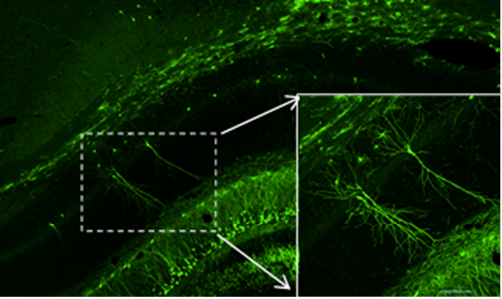Molecular Neuroscience

Example of CA1 pyramidal neurons expressing enhanced green fluorescent proteins, two weeks after lentiviral injection into the dorsal CA1 area. From Figure 1 of Yu et al (2016).
This is the newest branch of the Disterhoft Laboratory. We have established a number of methods that include quantitative Western blotting, immunohistochemistry, q-RT-PCR, and in vivo shRNA viral vector “gene therapy”. We are equipped to perform many standard techniques that include cloning, in situ hybridization, RT-PCR, and ELISA.
We are primarily interested in a translational approach where molecular targets associated with learning, neuronal excitability, and lifespan may be identified and manipulated for potential therapeutic utility for cognitive disorders and aging-associated dementia.
Current projects:
- Ameliorate aging-related learning and memory deficits by overexpressing CREB in dorsal CA1 region of aged rats
- Measurement and quantification of various voltage-gated calcium channels that regulate the afterhyperpolarization in young and aging animals during learning
- Design and delivery of therapeutic shRNAs directed against multiple signaling targets in animal models of Alzheimer’s and aging-associated dementia
- Assay biochemical pathways that participate in the expression of normal and aging-associated learning and memory
Recent Publications:
- Yu XW, Curlik DM, Oh MM, Disterhoft JF. CREB overexpression in dorsal CA1 ameliorates long-term memory deficits in aged rats. ELife. 2017 Jan 4;6. pii: e19358. doi: 10.7554/eLife.19358. PubMed PMID: 28051768; PMCID: PMC5214885.
- Yu XW, Oh MM, Disterhoft JF. CREB, cellular excitability, and cognition: Implications for aging. Behav Brain Res. 2016 Jul 28. pii: S0166-4328(16)30477-6. doi:10.1016/j.bbr.2016.07.042. [Epub ahead of print] PubMed PMID: 27478142.
